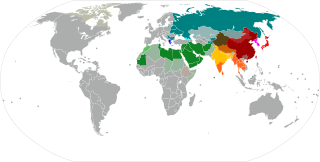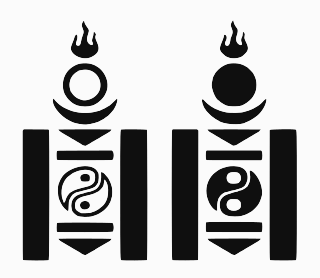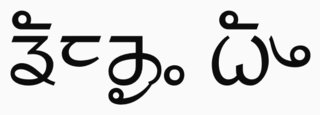
An abugida – sometimes also called alphasyllabary, neosyllabary, or pseudo-alphabet – is a segmental writing system in which consonant–vowel sequences are written as units; each unit is based on a consonant letter, and vowel notation is secondary, similar to a diacritical mark. This contrasts with a full alphabet, in which vowels have status equal to consonants, and with an abjad, in which vowel marking is absent, partial, or optional – in less formal contexts, all three types of the script may be termed "alphabets". The terms also contrast them with a syllabary, in which a single symbol denotes the combination of one consonant and one vowel.

The Brahmic scripts, also known as Indic scripts, are a family of abugida writing systems. They are used throughout the Indian subcontinent, Southeast Asia and parts of East Asia. They are descended from the Brahmi script of ancient India and are used by various languages in several language families in South, East and Southeast Asia: Indo-Aryan, Dravidian, Tibeto-Burman, Mongolic, Austroasiatic, Austronesian, and Tai. They were also the source of the dictionary order (gojūon) of Japanese kana.
Malayalam script is a Brahmic script used commonly to write Malayalam, which is the principal language of Kerala, India, spoken by 45 million people in the world. It is a Dravidian language spoken in the Indian state of Kerala and the union territories of Lakshadweep and Puducherry by the Malayali people. It is one of the official scripts of the Indian Republic. Malayalam script is also widely used for writing Sanskrit texts in Kerala.

The Tibetan script is a segmental writing system, or abugida, derived from Brahmic scripts and Gupta script, and used to write certain Tibetic languages, including Tibetan, Dzongkha, Sikkimese, Ladakhi, Jirel and Balti. It was originally developed c. 620 by Tibetan minister Thonmi Sambhota for King Songtsen Gampo.

The Soyombo script is an abugida developed by the monk and scholar Zanabazar in 1686 to write Mongolian. It can also be used to write Tibetan and Sanskrit.

Surat Buhid is an abugida used to write the Buhid language. As a Brahmic script indigenous to the Philippines, it closely related to Baybayin and Hanunó'o. It is still used today by the Mangyans, found mainly on island of Mindoro, to write their language, Buhid, together with the Filipino latin script.

The Phagspa, ʼPhags-pa or ḥPʻags-pa script is an alphabet designed by the Tibetan monk and State Preceptor Drogön Chögyal Phagpa (1235–1280) for Kublai Khan, the founder of the Yuan dynasty (1271–1368) in China, as a unified script for the written languages within the Yuan. The actual use of this script was limited to about a hundred years during the Mongol-led Yuan dynasty, and it fell out of use with the advent of the Ming dynasty.

The Cham script is a Brahmic abugida used to write Cham, an Austronesian language spoken by some 245,000 Chams in Vietnam and Cambodia. It is written horizontally left to right, just like other Brahmic abugidas.

The Limbu script is used to write the Limbu language. It is a Brahmic type abugida.
The Rañjanā script (Lantsa) is an abugida writing system which developed in the 11th century and until the mid-20th century was used in an area from Nepal to Tibet by the Newar people, the historic inhabitants of the Kathmandu Valley, to write Sanskrit and Newar. Nowadays it is also used in Buddhist monasteries in China, especially in the Tibetan Buddhist areas within the Tibet Autonomous Region, Sichuan, Yunnan, Qinghai and Gansu; Mongolia, and Japan. It is normally written from left to right but the Kutakshar form is written from top to bottom. It is also considered to be the standard Nepali calligraphic script.

The Pollard script, also known as Pollard Miao or Miao, is an abugida loosely based on the Latin alphabet and invented by Methodist missionary Sam Pollard. Pollard invented the script for use with A-Hmao, one of several Miao languages spoken in southeast Asia. The script underwent a series of revisions until 1936, when a translation of the New Testament was published using it.

Mandombe or Mandombé is a script proposed in 1978 in Mbanza-Ngungu in the Bas-Congo province of the Democratic Republic of the Congo by Wabeladio Payi, who related that it was revealed to him in a dream by Simon Kimbangu, the prophet of the Kimbanguist Church. Mandombe is based on the sacred shapes and , and intended for writing African languages such as Kikongo, as well as the four national languages of the Congo, Kikongo ya leta, Lingala, Tshiluba and Swahili, though it does not have enough vowels to write Lingala fully. It is taught in Kimbanguist church schools in Angola, the Republic of the Congo, and the Democratic Republic of the Congo. It is also promoted by the Kimbanguist Centre de l’Écriture Négro-Africaine (CENA). The Mandombe Academy at CENA is currently working on transcribing other African languages in the script. It has been classified as the third most viable indigenous script of recent indigenous west African scripts, behind only the Vai syllabary and the N'Ko alphabet.
Zhangzhung is an extinct Sino-Tibetan language that was spoken in Zhangzhung in what is now western Tibet. It is attested in a bilingual text called A Cavern of Treasures and several shorter texts.

The Kayah Li alphabet is used to write the Kayah languages Eastern Kayah Li and Western Kayah Li, which are members of Karenic branch of the Sino-Tibetan language family. They are also known as Red Karen and Karenni. Eastern Kayah Li is spoken by about 26,000 people, and Western Kayah Li by about 100,000 people, mostly in the Kayah and Karen states of Myanmar, but also by people living in Thailand.

Newari scripts are a family of alphabetic writing systems employed historically in Nepal Mandala by the indigenous Newar people for primarily writing Nepal Bhasa. It is also used for transcribing Sanskrit and Pali. There are also some claims they have also been used to write the Parbatiya (Khas) language.
Bassa Vah, also known as simply Vah is an alphabetic script for writing the Bassa language of Liberia. As an old system nearing extinction in the 1900s, it was rediscovered among Bassa in Brazil and the West Indies, then revived in Liberia, by Thomas Flo Lewis. Type was cast for it, and an association for its promotion was formed in Liberia in 1959. It is not used today and has been classified as a failed script.
The Osage script is a new script promulgated in 2006 and revised 2012–2014 for the Osage language. Because Latin orthographies were subject to interference from English conventions among Osage students who were more familiar with English than with Osage, in 2006 the director of the Osage Language Program, Herman Mongrain Lookout, decided to create a distinct script by modifying or fusing Latin letters. This Osage script has been in regular use on the Osage Nation ever since.
Marchen is a Unicode block containing characters from the Marchen alphabet, which has been used to write the extinct Zhang-Zhung language of the Zhang-zhung culture of Tibet. In modern Bon usage, Marchen is also used to write Tibetan.

Zanabazar's square script is a horizontal Mongolian square script, an abugida developed by the monk and scholar Zanabazar based on the Tibetan alphabet to write Mongolian. It can also be used to write Tibetan language and Sanskrit as a geometric typeface.













